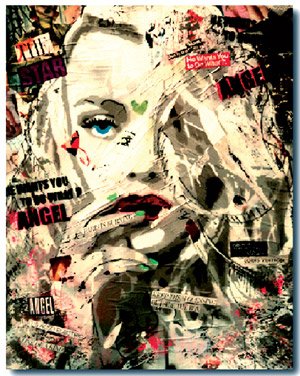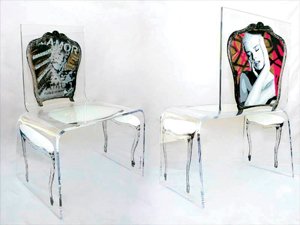Portland Artist Yannick Hamon


French-born artist Yannick Hamon is basically a stencil wizard. With exhibits in San Francisco, L.A., New York, and Miami selling out like hotcakes, designers and art collectors are turning to Yannick for an updated kick to what we think of as a contemporary art. Street art influences and a French eye for beauty and sensuality are combined with the meticulous detail of a true old school classically trained calligraphy artist. Really, it’s no mystery why Yannick is capturing new fans young and old.
ELEVEN: Will you describe your process?
Yannick Hamon: Whenever I see a photo that I really like, I look at it and say, “What can I do with this?” This is how everything really starts. The next step is the stencil. Nothing is screen printed. A lot of people might see my work and think that it’s a screen print, but it’s not. Everything is really handmade and hand cut. The stencils take maybe about three weeks, working every day. I have nothing against screen prints or anything, but you know this is all handmade. This is not graffiti art. Just because I use spray paint doesn’t make me a graffiti artist. This is pop art contemporain.
I started with furniture—antique french furniture. When I was still in France and I would try to buy the furniture, and if the antique seller found out what I planned on doing with the furniture, they often wouldn’t sell it to me because they said it was just a crime to do what I was planning [to the antiques]. When I told them that I was going to paint it pink or green they said, “No, I wont sell it to you.” They might give me a few phone numbers of some knock-off retailers. The process to customize the furniture was a bit too long and quite expensive.
I did not see myself working for an agency doing logos all day after I graduated from art school because I knew that after two months I would be totally bored and going crazy. So this is when I said, “Ok you know how to work images so why don’t you find out how to use them in a different way.” I really wanted to do art, to make art.

collage on canvas, 2013)
11: Did you experience any bias from your family when you told them you wanted to go to art school? Did they try to talk you out of it and into a more “practical” career? I’m just curious if this type of thing happens in France like it does in America when young adults tell their families they want to go to art school.
YH: No, I think my parents were maybe a bit scared, but they would have been more scared if I went to a worse school. My mom has always been and still is very supportive. When I was twenty I said to my parents that I wanted to go to graphics school. It was a bit expensive, but they knew that it was what I really wanted to do so they said ok. It wasn’t in a true school or classroom. It was in this guy’s attic—Bernard Arin at the Scriptorium de Toulouse. He was one of the guys that really changed calligraphy as we know it. He currently holds the title of best calligrapher in France. I studied typography and calligraphy.
Yes, there is also the stereotype about artists in France too. Like my aunt and uncle think I’m just this hippie who just doesn’t make a living. No, I wake up every morning and paint or work on the stencils from eight a.m. to sometimes ten p.m. This is my sole income. I do not have another job. This is my job. I had an interesting conversation with a well known artist in France a few years ago, and he told me that there are lots of times when you say to yourself, “Okay, I’m going to give up,” or “This isn’t going to work.” He said, “At one point, if you keep doing what you’re doing, it’s going to happen.”
11: Can you explain your experience being an artist in Portland?
YH: I think Portland is a very creative city, but I think for my type of art it’s really, really difficult. I think it’s really much more challenging here than when I show in San Francisco, L.A., New York, or even Miami. For example, in San Francisco the pieces sold out basically the opening night. And here there have been three exhibitions and only one piece sold. So in this way you can really see the difference. I think Portland is really missing a true—I don’t know how to explain it—something beyond what already exists here. In four years I have not found a gallery that is showing current works from around the world. If this gallery exists I have not found it.
11: Who is your ideal audience?
YH: I think my art can appeal to everybody. I had a 67-year-old woman who loves all my paintings, even the ones with the girls kissing each other. It depends on how people are thinking. It depends if people are open to having nudity in their house—if they are open to that or if they are not. I know lots of people who really love my painting, but because there is nudity in it, it’s impossible for them to hang it. I have people who have bought my paintings that are in their sixties and people who bought my paintings that are in their twenties. I sold a painting to a man here in his fifties, and when he took it home his wife was not really that happy. Well, he actually bought four or five paintings.
11: How do you stay motivated to create new work?
YH: It is what I really Iove to do. Even if what I’m doing right now—cutting two thousand itty bitty squares—is really boring. Like today I spent five hours to cut ten lines. But, you know, it’s what I love to do. I don’t really see myself doing something different. I really love the art industry. I’ve always had this passion.
11: What are your favorite things right now?
YH: Right now? At this time right now? I have to say fried foods. And, well, sneakers. We don’t really have fried foods in France, so I really like eating it.
11: Is there an artist who inspires you?
YH: Yes, a French artist. I think now he is in his eighties. His name is Jacques Villegle. He is doing collage, just collage. I think if you saw his work you can see how he’s influenced me. I am not doing collage like him, but you can really see how he has influenced my style. He started in the 1950’s, and if this guy was in his thirties right now he would be a rock star. He’s amazing.

11: Can you tell us about your collaboration with the designer Aaron R. Thomas?
YH: Well, I wanted to paint on a hard acrylic surface. I contacted some companies in the acrylic industry and they said it was impossible. I was like, “Alright, they are working in this industry so I think they know what they are talking about.” So, I left it alone, sad. Then I found this guy through Facebook who makes acrylic furniture. So I think I started to speak with him through Facebook maybe four or five years ago.
Last June when I was in L.A. I said, “Ok, so I really have to meet him.” I went and knocked on his door. At first we wanted to do something together, but just for fun. So when I sat down with him he looked at my work and was like, “Ok this is totally different from what you’re showing.” He agreed to work with me. After we did the first collaboration (with my painting on his acrylic chair), he said, “Okay, I think we are going to be working together for a very long time.” So a union was born.
At one point we were wondering what to do on the side of the chairs we were working on. We said, “Okay, let’s think about that later.” He went to take a shower, and when he came back I said, “I have an idea for the side of the chair!” He said, “Me too!” I was like, “Okay, so you first.” When he said his idea it was my idea too. It was really easy to work with him. We spoke this morning and we are talking about showing in galleries. His acrylic furniture with my painting. Also we are planning to show very big acrylic pieces that will hang on the wall, which is something that nobody is really doing right now. Everything [about Aaron’s process] is really hand made. Even the acrylic skateboards are all molded by hand. The next phase of the process will be painting on the large acrylic sheets like I wanted to do in the first place. Now Im going back to what I first wanted to do, but with a twist.
11: Are there any Portland artists you would like to recognize?
YH: Jon Stommel and Travis Czekalski. I like their work a lot. »
– Veronica Greene
Find more art from Yannick at: www.yannickhamonart.com




